study pool
WE OFFER WELL RESEARCHED , CREDIBALE READING AND REVISION MATERIALS .
PAST PAPERS , EXAMS , TEST PAPERS AND QUIZ PAPERS ALL AVAILABLE
NURSING
MED SURG
SOFTWARE ENGINEERING
ENGINEERING
ECONOMICS
LAW
ART
BIOLOGY
MATH
CHEMISTRY
ETC.
- 453
- 0
- 17
Community
- Followers
- Following
1 Reviews received
470 items

Raising the Bar for Success First Semester Johns Hopkins University Sensory Perception
Raising the Bar for Success First Semester Johns Hopkins University Sensory Perception Be able to know the differences between conductive and sensorineural hearing loss; know causes for both and nursing interventions for both. • Conductive – sound wave transmission interrupted b/w external canal and inner ear o Causes – external ear blockage (foreign body, ear wax), cerumen impaction, cholesteatoma, otitis media or externa, otosclerosis, serous otitis, tympanic membrane thick...
- Exam (elaborations)
- • 7 pages •
Raising the Bar for Success First Semester Johns Hopkins University Sensory Perception Be able to know the differences between conductive and sensorineural hearing loss; know causes for both and nursing interventions for both. • Conductive – sound wave transmission interrupted b/w external canal and inner ear o Causes – external ear blockage (foreign body, ear wax), cerumen impaction, cholesteatoma, otitis media or externa, otosclerosis, serous otitis, tympanic membrane thick...
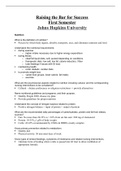
Raising the Bar for Success First Semester :Nutrition Johns Hopkins University (97% correct answers)
Raising the Bar for Success First Semester Johns Hopkins University Nutrition What is the definition of nutrition? • Process by which body ingests, absorbs, transports, uses, and eliminates nutrients and food Understand the nutritional requirements: • during exercise o higher intake necessary due to higher energy expenditure • during illness o clear/full liquid diets, soft, pureed depending on conditions o therapeutic diets: low salt, low fat, calorie reduction, ↑fiber ...
- Exam (elaborations)
- • 6 pages •
Raising the Bar for Success First Semester Johns Hopkins University Nutrition What is the definition of nutrition? • Process by which body ingests, absorbs, transports, uses, and eliminates nutrients and food Understand the nutritional requirements: • during exercise o higher intake necessary due to higher energy expenditure • during illness o clear/full liquid diets, soft, pureed depending on conditions o therapeutic diets: low salt, low fat, calorie reduction, ↑fiber ...
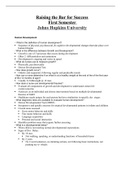
Raising the Bar for Success First Semester Johns Hopkins University Human Development ( 96% correct answers )
Raising the Bar for Success First Semester Johns Hopkins University Human Development – What is the definition of human development? • Sequence of physical, psychosocial, & cognitive developmental changes that take place over human lifespan - What is the difference between Growth and Development? • Growth is one of 3 processes that occurs during development • Other 2: differentiation and maturation • Development is ongoing and varies in speed - What do nurses use to ...
- Exam (elaborations)
- • 4 pages •
Raising the Bar for Success First Semester Johns Hopkins University Human Development – What is the definition of human development? • Sequence of physical, psychosocial, & cognitive developmental changes that take place over human lifespan - What is the difference between Growth and Development? • Growth is one of 3 processes that occurs during development • Other 2: differentiation and maturation • Development is ongoing and varies in speed - What do nurses use to ...
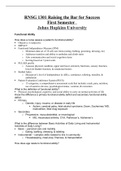
RNSG 1301 Raising the Bar for Success First Semester Johns Hopkins University (96% correct answers)
RNSG 1301 Raising the Bar for Success First Semester Johns Hopkins University Functional Ability How does a nurse assess a patient’s functional ability? • Objective vs subjective • IMPACT • Functional Independence Measure (FIM) o Minimum data set of 18 self-care items (eating, bathing, grooming, dressing, etc) o Addresses transfers and ability to ambulate and climb stairs o Also communication and social cognition items o Scoring based on 7-point scale • PULSES profil...
- Exam (elaborations)
- • 5 pages •
RNSG 1301 Raising the Bar for Success First Semester Johns Hopkins University Functional Ability How does a nurse assess a patient’s functional ability? • Objective vs subjective • IMPACT • Functional Independence Measure (FIM) o Minimum data set of 18 self-care items (eating, bathing, grooming, dressing, etc) o Addresses transfers and ability to ambulate and climb stairs o Also communication and social cognition items o Scoring based on 7-point scale • PULSES profil...
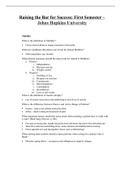
RNSG 1301 Raising the Bar for Success First Semester Johns Hopkins University
RNSG 1301 Raising the Bar for Success First Semester Johns Hopkins University Functional Ability How does a nurse assess a patient’s functional ability? • Objective vs subjective • IMPACT • Functional Independence Measure (FIM) o Minimum data set of 18 self-care items (eating, bathing, grooming, dressing, etc) o Addresses transfers and ability to ambulate and climb stairs o Also communication and social cognition items o Scoring based on 7-point scale • PULSES profil...
- Exam (elaborations)
- • 5 pages •
RNSG 1301 Raising the Bar for Success First Semester Johns Hopkins University Functional Ability How does a nurse assess a patient’s functional ability? • Objective vs subjective • IMPACT • Functional Independence Measure (FIM) o Minimum data set of 18 self-care items (eating, bathing, grooming, dressing, etc) o Addresses transfers and ability to ambulate and climb stairs o Also communication and social cognition items o Scoring based on 7-point scale • PULSES profil...
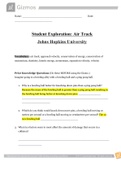
Physics Momentum with Air Tracks (Student Exploration: Air Track)- Johns Hopkins University
2. Click Reset ( ). The velocity (v) of an object describes its speed and direction. The velocity of each glider is indicated next to the v1 and v2 sliders. Click Play, and then click Pause ( ) just before the collision. A. What is the velocity of Glider 1? _________________________________________ B. In which direction does Glider 1 move? ___________________________________ C. What is the velocity of Glider 2? _________________________________________ D. In which direction does Gl...
- Exam (elaborations)
- • 15 pages •
2. Click Reset ( ). The velocity (v) of an object describes its speed and direction. The velocity of each glider is indicated next to the v1 and v2 sliders. Click Play, and then click Pause ( ) just before the collision. A. What is the velocity of Glider 1? _________________________________________ B. In which direction does Glider 1 move? ___________________________________ C. What is the velocity of Glider 2? _________________________________________ D. In which direction does Gl...
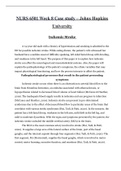
NURS 6501 Week 8 Case study – Ischemic Stroke Johns Hopkins University
A 74-year-old male with a history of hypertension and smoking is admitted to the ED for possible ischemic stroke. While eating dinner, the patient’s wife witnessed her husband have a sudden onset of difficulty speaking, left sided facial droop with drooling, and weakness in his left hand. The purpose of this paper is to explore how ischemic stroke can affect the neurological and musculoskeletal systems. Also, the paper will explain the pathophysiology of the patient’s symptoms, the ethnic va...
- Case
- • 4 pages •
A 74-year-old male with a history of hypertension and smoking is admitted to the ED for possible ischemic stroke. While eating dinner, the patient’s wife witnessed her husband have a sudden onset of difficulty speaking, left sided facial droop with drooling, and weakness in his left hand. The purpose of this paper is to explore how ischemic stroke can affect the neurological and musculoskeletal systems. Also, the paper will explain the pathophysiology of the patient’s symptoms, the ethnic va...
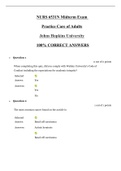
NURS 6531N Midterm Exam Practice Care of Adults Johns Hopkins University ( 100% CORRECT ANSWERS)
When completing this quiz, did you comply with Walden University’s Code of Conduct including the expectations for academic integrity? Selected Answer: Yes Answers: Yes No • Question 2 1 out of 1 points The most common cancer found on the auricle is: Selected Answer: Basal cell carcinoma Answers: Actinic keratosis Basal cell carcinoma Squamous cell carcinoma Acral-lentiginous melanoma
- Exam (elaborations)
- • 59 pages •
When completing this quiz, did you comply with Walden University’s Code of Conduct including the expectations for academic integrity? Selected Answer: Yes Answers: Yes No • Question 2 1 out of 1 points The most common cancer found on the auricle is: Selected Answer: Basal cell carcinoma Answers: Actinic keratosis Basal cell carcinoma Squamous cell carcinoma Acral-lentiginous melanoma

Knowledge Representation - Logic ( Artificial Intelligence ) : COMPUTER SCIENCE
The syntax: Vocabulary: A set of propositional symbols - e.g., P, Q, … A set of logical connectives or operators usually (OR), (AND), ¬ (NOT), (implication), maybe (equivalence), Parenthesis (for grouping) The special symbols True, False (logical constants)
- Class notes
- • 19 pages •
The syntax: Vocabulary: A set of propositional symbols - e.g., P, Q, … A set of logical connectives or operators usually (OR), (AND), ¬ (NOT), (implication), maybe (equivalence), Parenthesis (for grouping) The special symbols True, False (logical constants)

Knowledge Representation ( Artificial Intelligence ) : COMPUTER SCIENCE
Expressiveness of natural language: Very expressive, probably everything that can be expressed symbolically can be expressed in natural language (pictures, content of art, emotions are often hard to express) Probably the most expressive knowledge representation formalism we have. Reasoning is very complex, hard to model Problems with natural language: Natural language is often ambiguous. The syntax and semantics are not fully understood. There is little uniformity...
- Class notes
- • 24 pages •
Expressiveness of natural language: Very expressive, probably everything that can be expressed symbolically can be expressed in natural language (pictures, content of art, emotions are often hard to express) Probably the most expressive knowledge representation formalism we have. Reasoning is very complex, hard to model Problems with natural language: Natural language is often ambiguous. The syntax and semantics are not fully understood. There is little uniformity...

ATI PN MENTAL HEALTH PROCTORED EXAM 2020